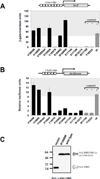Functional analysis of BRCA1 C-terminal missense mutations identified in breast and ovarian cancer families
- PMID: 11157798
- PMCID: PMC4756649
- DOI: 10.1093/hmg/10.4.353
Functional analysis of BRCA1 C-terminal missense mutations identified in breast and ovarian cancer families
Abstract
Germline mutations in the breast and ovarian cancer susceptibility gene BRCA1 are responsible for the majority of cases involving hereditary breast and ovarian cancer. Whereas all truncating mutations are considered as functionally deleterious, most of the missense variants identified to date cannot be readily distinguished as either disease-associated mutations or benign polymorphisms. The C-terminal domain of BRCA1 displays an intrinsic transactivation activity, and mutations linked to disease predisposition have been shown to confer loss of such activity in yeast and mammalian cells. In an attempt to clarify the functional importance of the BRCA1 C-terminus as a transcription activator in cancer predisposition, we have characterized the effect of C-terminal germline variants identified in Scandinavian breast and ovarian cancer families. Missense variants A1669S, C1697R, R1699W, R1699Q, A1708E, S1715R and G1738E and a truncating mutation, W1837X, were characterized using yeast- and mammalian-based transcription assays. In addition, four additional missense variants (V1665M, D1692N, S1715N and D1733G) and one in-frame deletion (V1688del) were included in the study. Our findings demonstrate that transactivation activity may reflect a tumor-suppressing function of BRCA1 and further support the role of BRCA1 missense mutations in disease predisposition. We also report a discrepancy between results from yeast- and mammalian-based assays, indicating that it may not be possible to unambiguously characterize variants with the yeast assay alone. We show that transcription-based assays can aid in the characterization of deleterious mutations in the C-terminal part of BRCA1 and may form the basis of a functional assay.
Figures



References
-
- Miki Y, Swensen J, Shattuck-Eidens D, Futreal PA, Harshman K, Tavtigian S, Liu Q, Cochran C, Bennett LM, Ding W, et al. A strong candidate for the breast and ovarian cancer susceptibility gene BRCA1. Science. 1994;266:66–71. - PubMed
-
- Friedman LS, Ostermeyer EA, Szabo CI, Dowd P, Lynch ED, Rowell SE, King MC. Confirmation of BRCA1 by analysis of germline mutations linked to breast and ovarian cancer in ten families. Nat. Genet. 1994;8:399–404. - PubMed
-
- Koonin EV, Altschul SF, Bork P. BRCA1 protein products … Functional motifs…. Nat. Genet. 1996;13:266–268. - PubMed
-
- Bork P, Hofmann K, Bucher P, Neuwald AF, Altschul SF, Koonin EV. A superfamily of conserved domains in DNA damage-responsive cell cycle checkpoint proteins. FASEB J. 1997;11:68–76. - PubMed
Publication types
MeSH terms
Substances
Grants and funding
LinkOut - more resources
Full Text Sources
Medical
Miscellaneous

